In 1968, the men’s event finals took place on Saturday, October 26, the very last day of competition at the Olympic Games.
Let’s take a look at what happened…
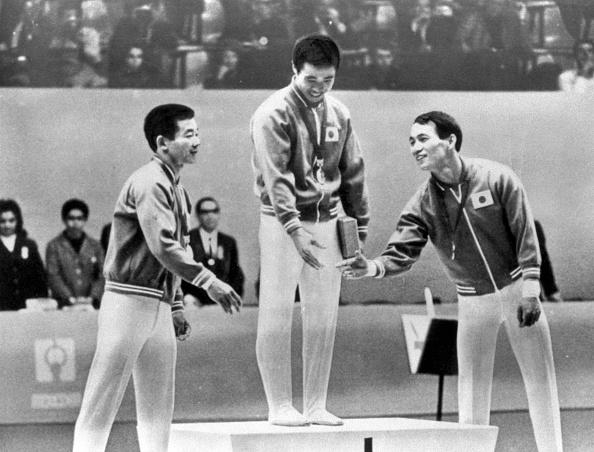
Video Footage | Competition Notes | Results
Competition Footage
The good news: There’s competition footage from the 1968 event finals.
The bad news: It’s not great.
Normally, I can watch the footage and figure out who’s who. But since the quality of the video makes it difficult to make out facial features, I know that I’ll misidentify the gymnasts for you.
Competition Notes
A big judging change: Judges would no longer be able to judge gymnasts from their own countries during event finals.
Only those judges who proved to be the most reliable and accurate during the compulsoryand optional sessions were used in the finals. Judges were also assigned so that there were no competitors from his own country on those events in which he was to judge.
Modern Gymnast, Nov/Dec. 1968
Here were the exact rules from the Code of Points:
1. The jury at each apparatus is composed of two referees and four judges.
2. One of the two referees must be of a nationality that is not represented in the particular finals (neutral).
3. The four judges must be of a nationality that is not represented in the particular finals (neutral).
Article 47, Code of Points, 1968
Mikhail Voronin won enough medals for an entire team.
A good harvest of medals was collected on the last day of the Olympic gymnastic tournament during the individual event finals. Muscovite Mikhail Voronin: his set of awards could be enough to adorn an entire team. That evening the Muscovite won two golds, two silvers and one bronze. Voronin won the vault and shared the winner’s laurels on high bar with the Japanese A. Nakayama.
Хороший урожай медалей собрал в последний день гимнастического олимпийского турнира, когда разыгрывалось’ первенство на отдельных снарядах, москвич Михаил Воронин. Набор его наград может стать украшением для целой команды. В этот вечер москвич завоевал две золотые, две серебряные и одну бронзовую медаль. Воронин победил в опорном прыжке и разделил лавры победителя в упражнениях на перекладине с японцем A. Накаяма.
Izvestiia, October 28, 1968
During event finals, Voronin’s golds were on vault and high bar. His silvers were on rings and parallel bars. His bronze was on pommel horse.
Voronin went home with seven medals from the Games — the most medals of any male gymnast. (Nakayama took home more golds but only six total medals.)
The event finals took a really long time.
The men’s finals, with 6 men in each event, lasted four hours!!! That amounts to about 45 minutes to one hour of action and about 3 hours for awards, judging, warm-up, debates, and etc.
Modern Gymnast, November/December 1968
Floor exercise was especially bad.
The meet, through the first few events was very listless and elicited little or no response from the spectators. The judges took a long time coming up with scores, there were long delays between events and, all in all, too little action.
Modern Gymnast, November/December 1968
As was vault.
The judges appeared to be asleep during the LH [Long Horse Vault] event as it took about one hour to run it off and 12,000 people got pretty restless because of it.
Modern Gymnast, November/December 1968
Men’s vault was boring.
In fact, it was so boring that some gymnastics coaches wanted to get rid of men’s vault. At an FIG course for coaches in 1969, the topic was brought up. Schuhwere, the Junior National Coach from Switzerland, said:
Concerning the long horse event. We must either re-evaluate this event or eliminate it.·
Modern Gymnast, June/July 1969
Arthur Gander (FIG President) agreed:
Gander followed Ivancevic by stating that long horse must look for new tactics and be made more attractive to all. “No one wants to sit through the same exercise over and over. People are squirming in their seats.”
Modern Gymnast, June/July 1969
We’ll discuss this meeting at length in the near future.
Speaking of vault…
Code Confusion: Are Yamashitas and handsprings different vault categories?
Gymnasts had to perform two vaults from different vault categories. But for some, it was not clear that a handspring and a Yamashita (a handspring with a pike) were from separate vault categories.
Here’s what Jerry Wright said in Modern Gymnast:
Takeshi Kato performed Yamashita from far end and handspring from far end which I thought was against the new rules but I never was able to find an answer to this.
Endo looked fairly well here although he too did two handsprings from the far end, one was piked and one straight body but the rules say one has to he with a ½ turn.
Modern Gymnast, November/December 1968
Note: You could perform vaults from the same category if you added a salto or a twist to them. In this code, a Yamashita and a handspring were separate vault categories — hence the different names: handspring and Yamashita.
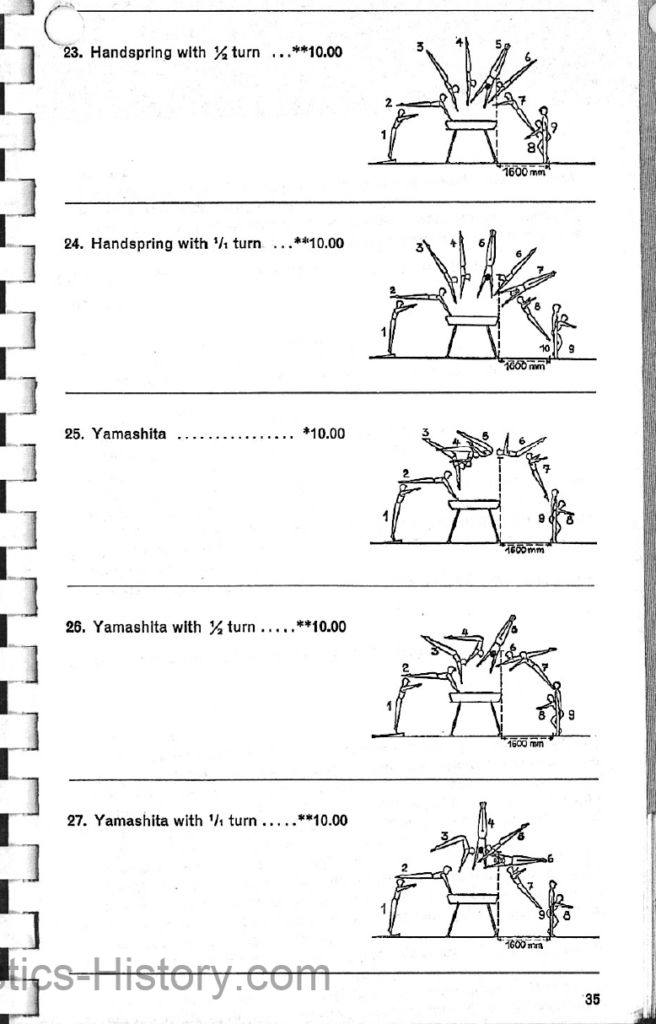
Here were the exact rules:
3. The two vaults to be performed may not belong to the same category, not even in the case when one of the vaults with support on the near end of the horse and the other on the far end of the horse are chosen. For example, two handsprings, two hechts, or two Hollanders may not be performed.
4. Two vaults of the same category may only be performed if one is chosen with rotation around the longitudinal axis of the body, or if a free somersault forward is added to the vault, even if the support is executed both times on the same end of the horse.
…
6. If a gymnast performs two vaults of the same category and one of them without rotation, he receives 0.50 points less for the second vault.
Artilce 59, Code of Points, 1968
The new rules about reserve athletes worked.
Reminder: At the 1966 World Championships, Tsurumi Shuji qualified for every event final, but he was injured during his rings routine. Only five gymnasts competed in the finals on the three remaining events (vault, parallel bars, and high bar).
Afterward, the FIG created a rule that there would be two alternates per event, and each alternate had to be in competition attire, warmed up, and ready to compete.
Here were the rules in the 1968 Code of Points:
3. The six gymnasts (who rank among the first six) are admitted to compete in the individual finals for an event on the basis of the results obtained in the compulsory and the optional exercises. If one or more of the finalists renounces his participation in the finals on an apparatus in accordance with article 34 d) of the technical regulations, the gymnast(s) who is next in rank will be considered.
4. In addition to the six finalists in every event, the directors of competition will determine the next two following gymnasts on the list to be used as reserves. They must be ready to compete on the particular apparatus during the finals in order to take the place of one of the finalists in case of incapacitation. If these gymnasts are not ready, the consequence may lead to deductions for unsportsmanlike behavior in the individual or team results; or even elimination from the ranking list.
Article 45, Code of Points, 1968
At the Olympics, Kato Sawao injured himself during the vault warm-ups, taking him out of the finals. The 7th gymnast was able to jump in for a total of six gymnasts on each event:
Sawao Kato pulled a muscle while competing* in the vault and had to pull out. He was replaced by Akinori Nakayama. Sawao had to be carried out of the gym in stretcher.
The Yomiuri, Oct. 28, 1968
*Modern Gymnast reported that the injury happened during warm-ups, which would make more sense.
The Wrongful Winner on Parallel Bars?
Jerry Wright felt that Voronin should have won gold. He called it “one of what appeared to be two mistakes the judges made during the finals.”
For More…
For more on what happened in event finals, check out Jerry Wright’s recap from the November/December 1968 issue of Modern Gymnast.
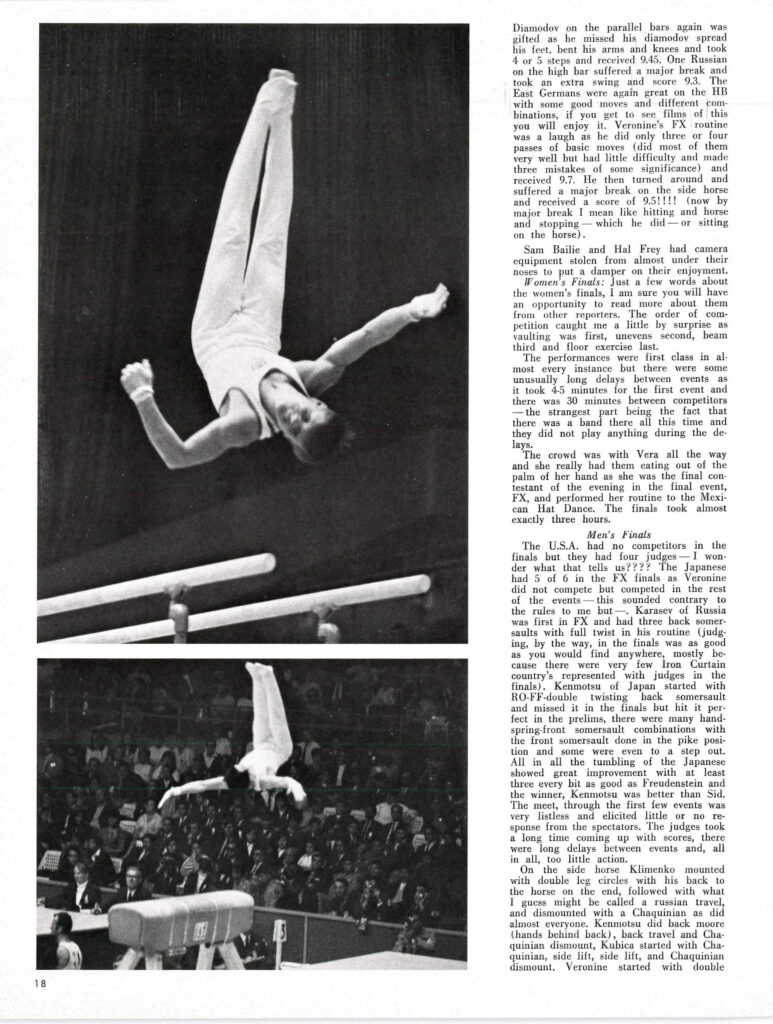
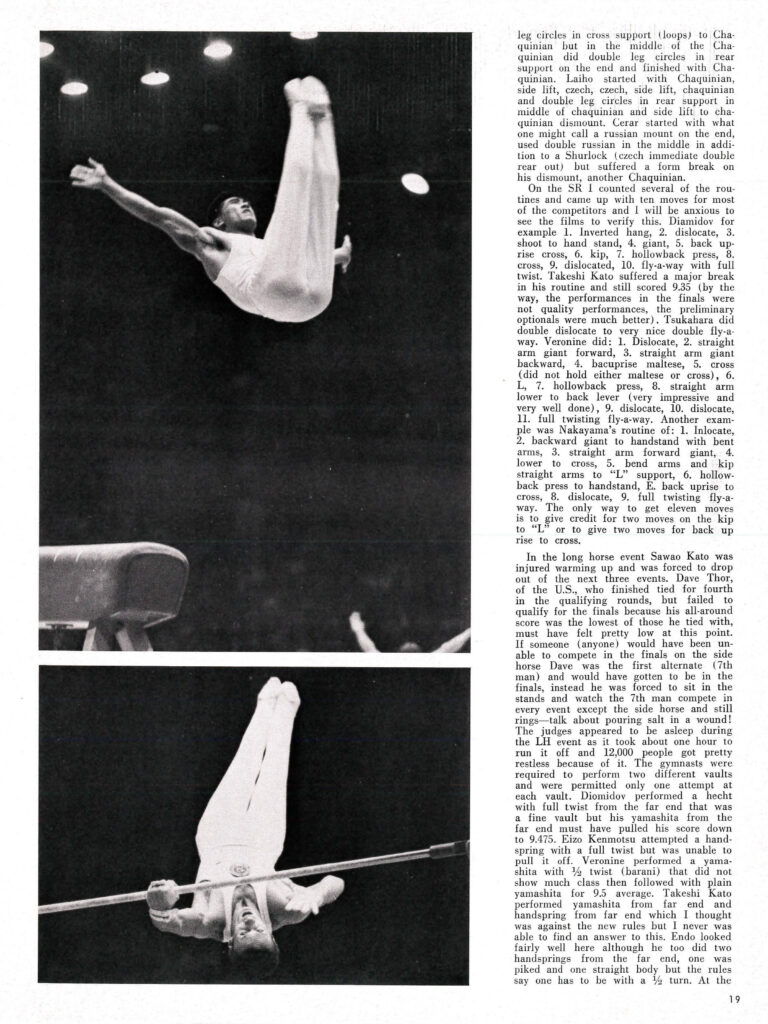
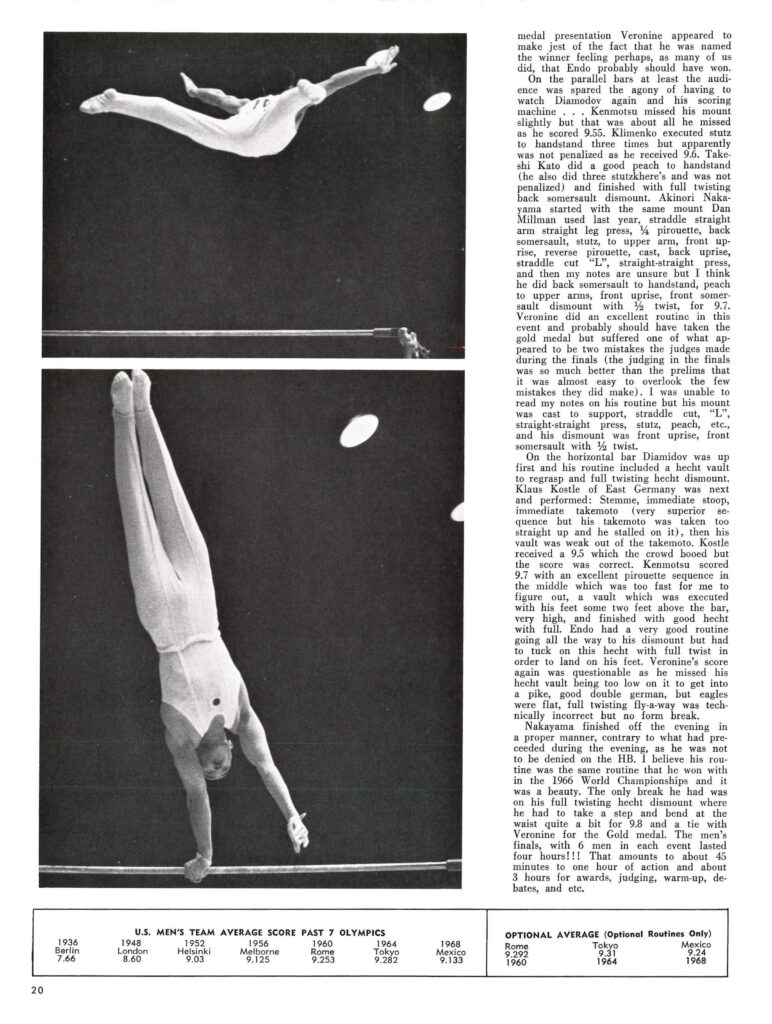
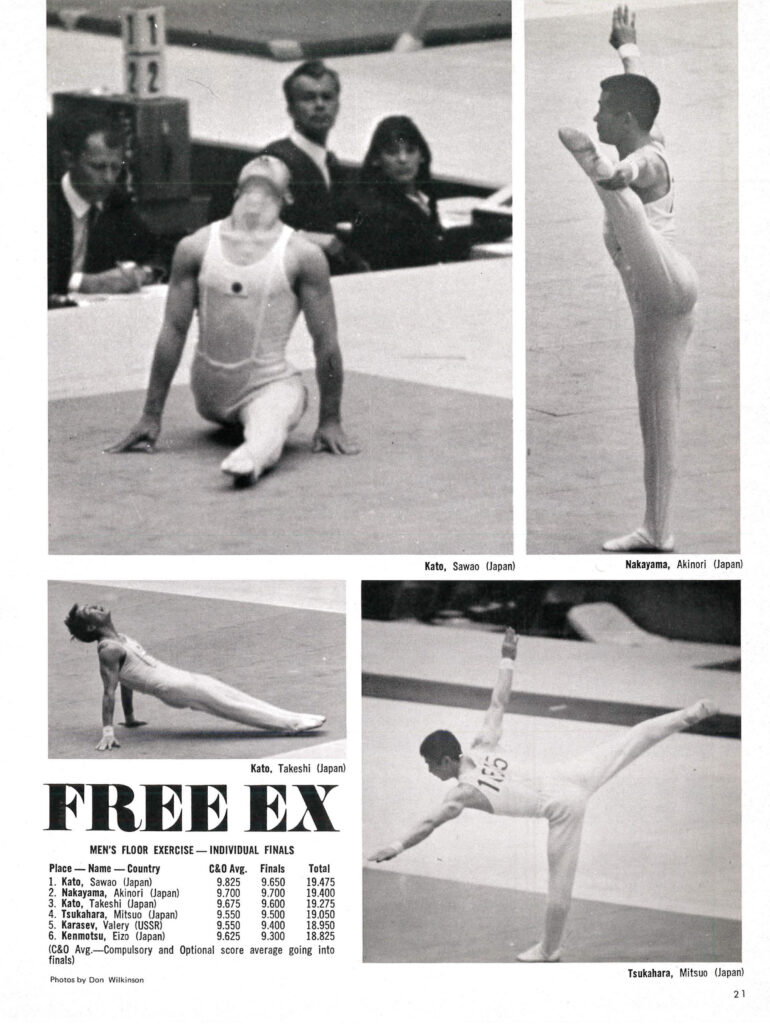
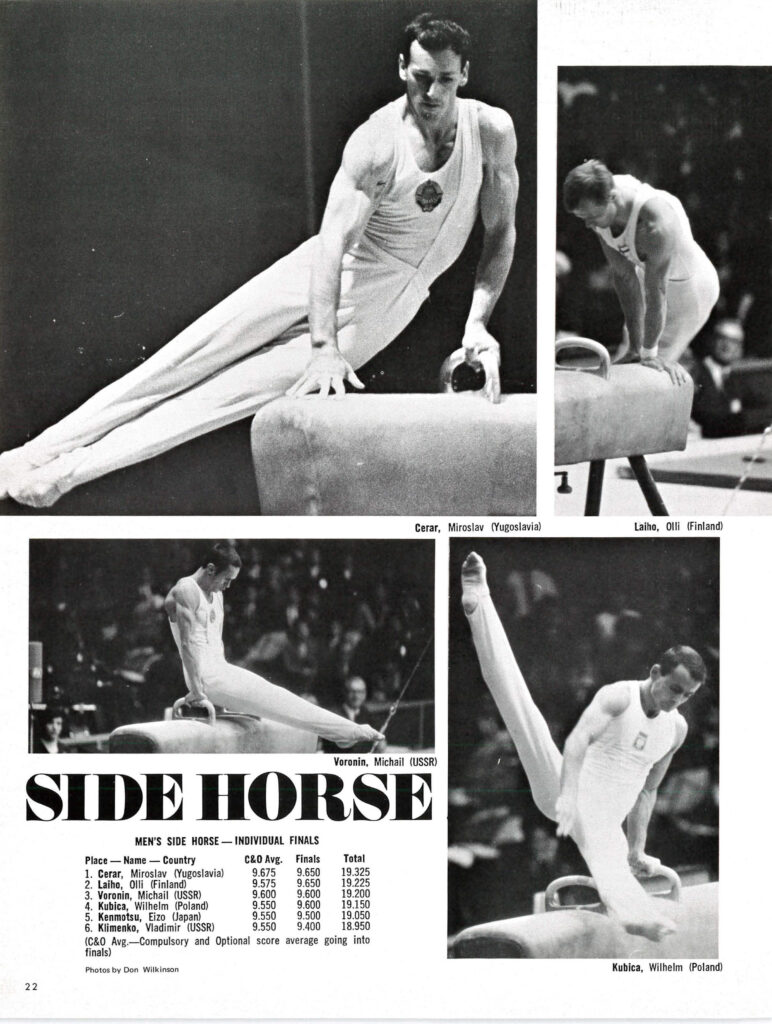
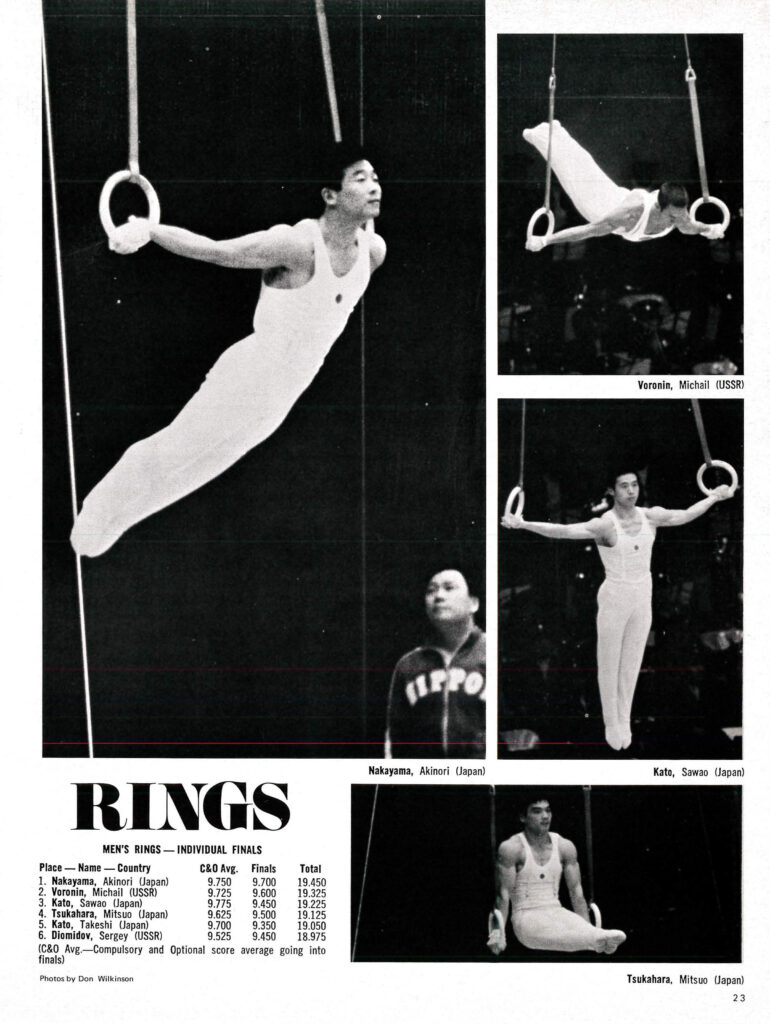
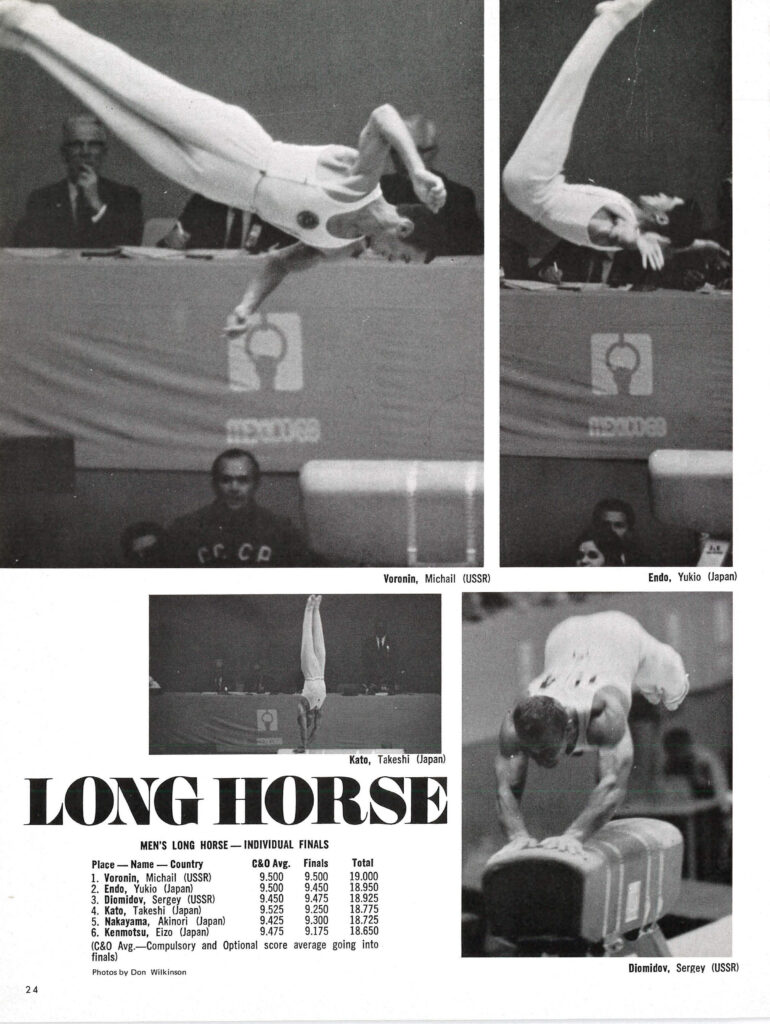
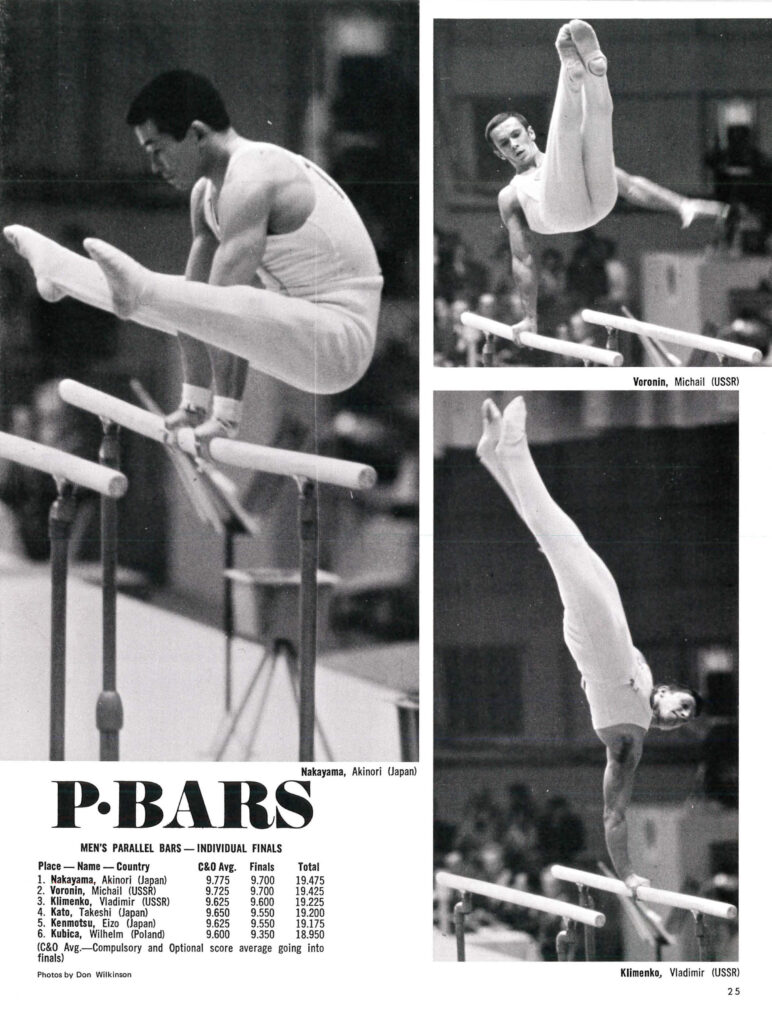
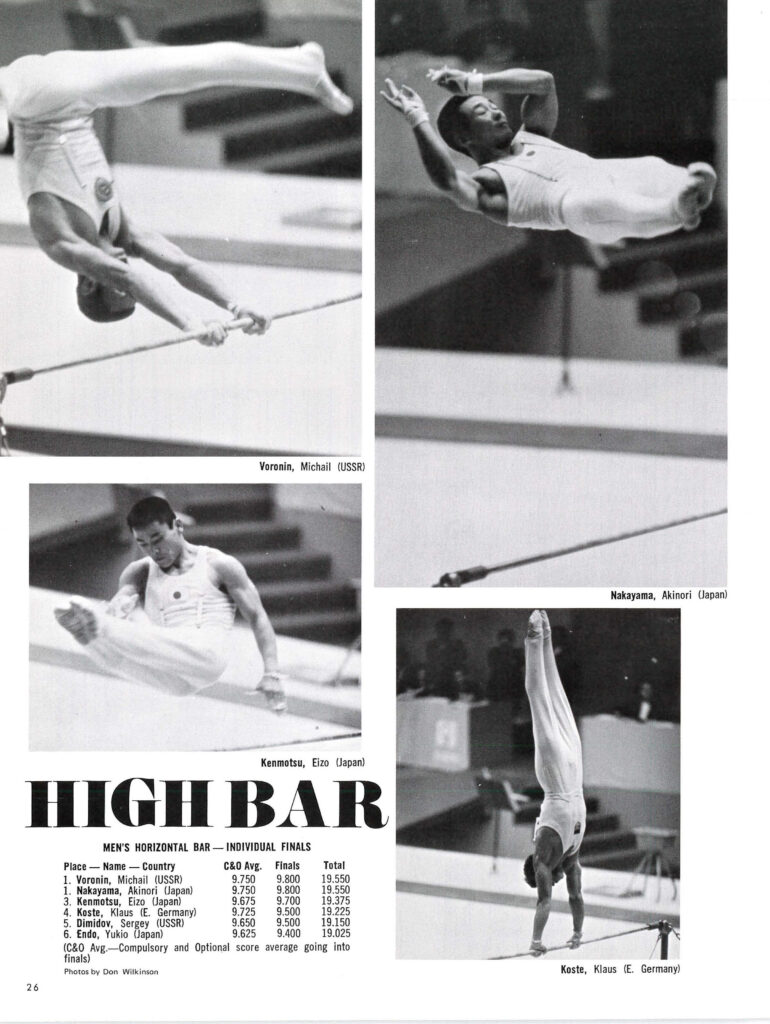
The Results
Reminder: Only six gymnasts qualified for event finals. Qualification for finals was based on the compulsory *and* optional scores on each event.
Your total score was the average of your compulsory and optional scores (labeled “COA” in the tables below) plus the score for your routine during event finals.
Floor Exercise (or Free Exercise)
| Name | Country | COA | Finals | Total |
| 1. Kato S. | JPN | 9.825 | 9.650 | 19.475 |
| 2. Nakayama | JPN | 9.700 | 9.700 | 19.400 |
| 3. Kato T. | JPN | 9.675 | 9.600 | 19.275 |
| 4. Tsukahara | JPN | 9.550 | 9.500 | 19.050 |
| 5. Karasev | URS | 9.550 | 9.400 | 18.950 |
| 6. Kenmotsu | JPN | 9.625 | 9.300 | 18.925 |
Kenmotsu fell on his double full in finals.
Pommel Horse (or Side Horse)
| Gymnast | Country | COA | Finals | Total |
| 1. Cerar | YUG | 9.675 | 9.650 | 19.325 |
| 2. Laiho | FIN | 9.575 | 9.650 | 19.225 |
| 3. Voronin | URS | 9.600 | 9.600 | 19.200 |
| 4. Kubica, W. | POL | 9.550 | 9.600 | 19.150 |
| 5. Kenmotsu | JPN | 9.550 | 9.500 | 19.050 |
| 6. Klimenko | URS | 9.550 | 9.400 | 18.950 |
The only podium without a Japanese gymnast on it.
Still Rings
| Gymnast | Country | COA | Finals | Total |
| 1. Nakayama | JPN | 9.750 | 9.700 | 19.450 |
| 2. Voronin | URS | 9.725 | 9.600 | 19.325 |
| 3. Kato S. | JPN | 9.775 | 9.450 | 19.225 |
| 4. Tsukahara | JPN | 9.625 | 9.500 | 19.125 |
| 5. Kato T. | JPN | 9.700 | 9.350 | 19.050 |
| 6. Diomidov | URS | 9.525 | 9.450 | 18.975 |
Long Horse Vault
| Gymnast | Country | COA | Finals | Total |
| 1. Voronin | URS | 9.500 | 9.500 | 19.000 |
| 2. Endo | JPN | 9.500 | 9.450 | 18.950 |
| 3. Diomidov | URS | 9.450 | 9.475 | 18.925 |
| 4. Kato T. | JPN | 9.525 | 9.250 | 18.775 |
| 5. Nakayama | JPN | 9.425 | 9.300 | 18.725 |
| 6. Kenmotsu | JPN | 9.475 | 9.175 | 18.650 |
Kato Sawao was injured during warm-ups.
Parallel Bars
| Gymnast | Country | COA | Finals | Total |
| 1. Nakayama | JPN | 9.775 | 9.700 | 19.475 |
| 2. Voronin | URS | 9.725 | 9.700 | 19.425 |
| 3. Klimenko | URS | 9.625 | 9.600 | 19.225 |
| 4. Kato T. | JPN | 9.650 | 9.550 | 19.200 |
| 5. Kenmotsu | JPN | 9.625 | 9.550 | 19.175 |
| 6. Kubica, W. | POL | 9.600 | 9.350 | 18.950 |
Horizontal Bar
| Gymnast | Country | COA | Finals | Total |
| 1T. Voronin | URS | 9.750 | 9.800 | 19.550 |
| 1T. Nakayama | JPN | 9.750 | 9.800 | 19.550 |
| 3. Kenmotsu | JPN | 9.675 | 9.700 | 19.375 |
| 4. Köste | GDR | 9.725 | 9.500 | 19.225 |
| 5. Diomidov | URS | 9.650 | 9.500 | 19.150 |
| 6. Endo | JPN | 9.625 | 9.400 | 19.025 |
More from 1968